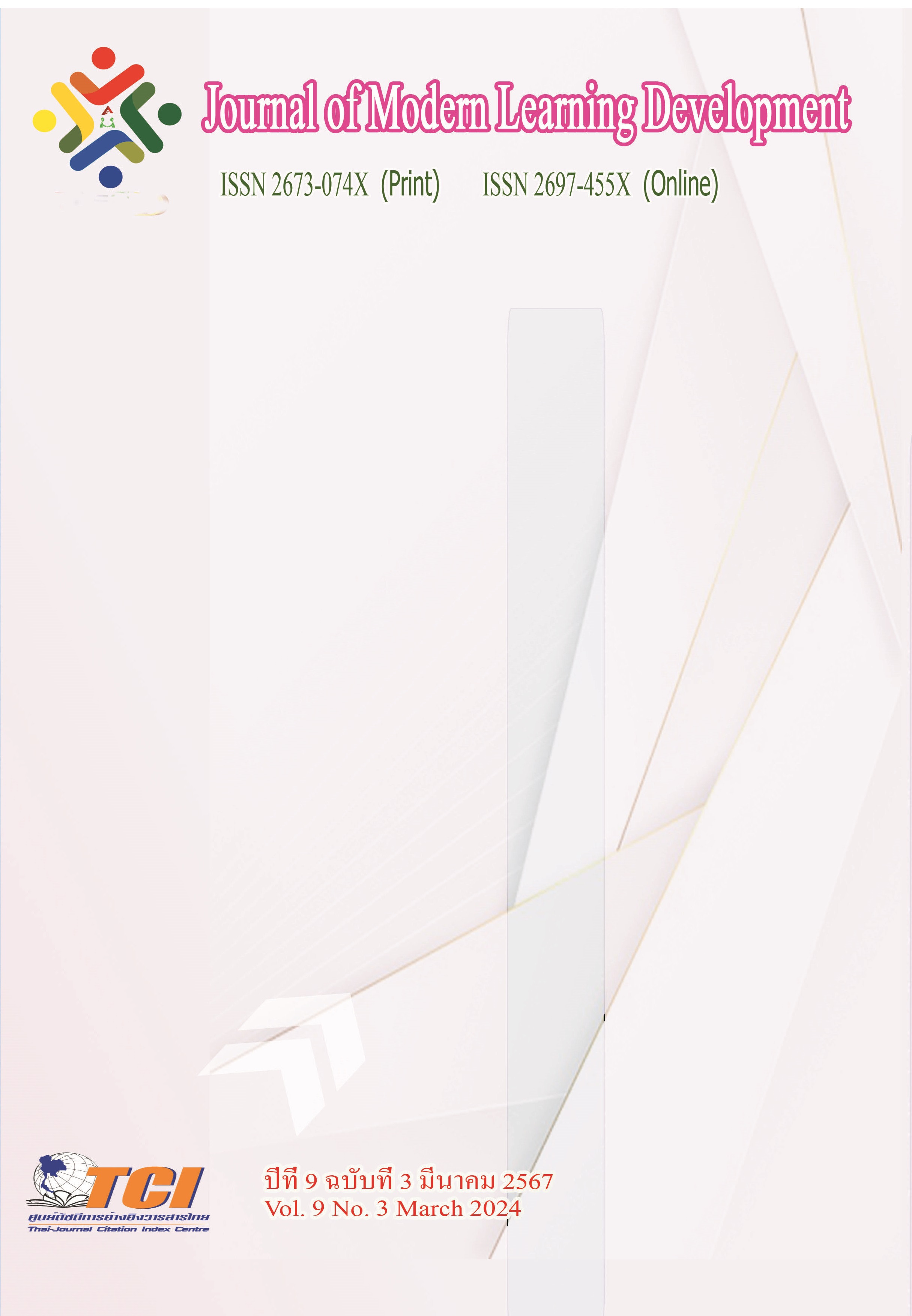A Study on the meaning of the toponyms of tourist attractions in Hangzhou, Zhejiang Province, China
Main Article Content
Abstract
The objective of this research is to analyze the significance of the names assigned to tourist attractions in Hangzhou, Zhejiang Province, China. This qualitative study utilizes document analysis to synthesize information collected from 449 viewpoints and scenic spots in Hangzhou. The specific names of tourist attractions can be categorized into the following groups: (1) Animals, (2) Administrative regions and street names, (3) Trees, flowers, and plants, (4) Occupations, community products, community Highlights, and culture, (5) Time and historical periods, (6) Personal names, (7) Entertainment and activities, (8) Deities and religions, (9) Mountains, city gates, forts, and rivers, (10) Modern terminology, (11) Directions, (12) Rankings, (13) Theater, literature, storytelling, paintings, and poems, (14) Climate and seasons, (15) Auspicious meaning, (16) Medicine and health, (17) Politics, (18) Company names, (19) Musical instruments, (20) Ethnic groups and minorities, and (21) Replications from original names. Additionally, there are general names that can be further divided into: (1) Natural landscapes, (2) Architectural structures, museums, centers, and stations, (3) Villages and rural areas, (4) Religion, (5) Streets, lanes, and alleys, (6) Accommodation places and resorts, (7) Entertainment and activities,and (8) Historical sites. Studying the meanings of the place names in this tourist attractions enables us to observe the distinctive features of the area of Hangzhou city. This study delves into the specific and general connotations of place names, which reflect the distinctive natural symbols of the area. These names have been deeply ingrained over an extensive period, becoming an integral part of the cultural fabric in this region that deserves further academic exploration.
Article Details
References
นิรัตน์ มุมทอง. (2550). ศึกษาความสัมพันธ์ระหว่างภูมินามที่มาจากภาษาเขมรถิ่นไทยกับลักษณะทางภูมิศาสตร์จังหวัดสุรินทร์. วิทยานิพนธ์ปริญญามหาบัณฑิต สาขาวิชาภูมิศาสตร์. บัณฑิตวิทยาลัย: มหาวิทยาลัยศรีนครินทรวิโรฒ.
ปภัสรา คำวชิรพิทักษ์. (2553). การศึกษาชื่อหมู่บ้านในจังหวัดชัยภูมิ. วารสารช่อพะยอม. 21, 3-16.
ไพฑูรย์ ปิยะปกรณ์. (2537). ภูมินามการตั้งถิ่นฐานหมู่บ้านชนบทในภาคตะวันออกเฉียงเหนือ: วิเคราะห์รูปแบบทางภูมิศาสตร์ของนามทั่วไป. วารสารภาษาและวัฒนธรรม. 13 (2), 49-60.
มัสวิณี สาและ. (2562). ภูมินามหมู่บ้านในจังหวัดยะลา: การวิเคราะห์ชื่อหมู่บ้านในบริบทด้านภาษา สังคมและวัฒนธรรม. วิทยานิพนธ์ปริญญาดุษฎีบัณฑิต สาขาวิชาภาษาศาสตร์. บัณฑิตวิทยาลัย: มหาวิทยาลัยนเรศวร.
รัตนดรุณ มณีเนตร, บุุญยงค์ เกศเทศ และ กัลยา กุลสุวรรณ. (2559). วัฒนธรรมภาษาในการตั้งชื่อบ้านนามเมืองของกลุ่มชาติพันธุ์ไทยเขมร และไทยกูย ในตำบลดองกำเม็ด อำเภอขุขันธ์ จังหวัดศรีสะเกษ. วารสารมนุษยศาสตร์และสังคมศาสตร์ มหาวิทยาลัยราชภัฏอุบลราชธานี. 7 (2), 55-69.
ศูนย์ข้อมูลเพื่อธุรกิจไทยในจีน สถานเอกอัครราชทูต ณ กรุงปักกิ่ง. (ม.ป.ป.). มณฑลเจ้อเจียง. ออนไลน์. สืบค้นเมื่อวันที่ 25 มกราคม 2566. แหล่งที่มา: https://thaibizchina.com/country/zhejiang/
สุพัตรา จิรนันทนาภรณ์ และ อัญชลี สิงห์น้อย. (2547). ภูมินามของหมู่บ้านในเขตภาคเหนือตอนล่างจังหวัดเพชรบูรณ์ (รายงานการวิจัย). พิษณุโลก: มหาวิทยาลัยนเรศวร.
สุพัตรา จิรนันทนาภรณ์ และ อัญชลี สิงห์น้อย. (2548). โครงสร้างทางภาษาภูมินามของหมู่บ้านในจังหวัดพิษณุโลก. ภาษาและภาษาศาสตร์. 23 (2), 75-94.
โอฬาร รัตนภักดี และ วิมลศิริ กลิ่นบุบผา. (2553). ภูมิลำเนาของหมู่บ้านในจังหวัดลำพูน. วารสารมนุษยศาสตร์วิชาการ คณะมนุษยศาสตร์ มหาวิทยาลัยเกษตรศาสตร์. 17 (1), 58-84.
Duncan Light. (2014). Tourism and toponymy: commodifying and consuming place names. Tourism Geographies. 16 (1), 141-156.
陈梦家. (1988).殷墟卜辞综述. 北京: 中华书局。
程郗熙. (2020). 上海市地名用字及其语言文化研究. 文学硕士学位论文. 研究生院: 四川外国语大学。
杭州简史编委会. (2022). 杭州简史. (重印). 杭州:杭州出版社。杭州市文化广电旅游局 资讯网.(n.d.).杭州.online. Retrieved on 10 Jan 2023. Retrieved from: https://wgly. hangzhou.gov.cn/cn/tszl/you/jdjq/index.html
黎科. (2022). 浙江地名文化遗产的数字化保护策略研究—以宁波为例. 文化创新比较研究,6 (13), 85-89。
刘泽玲. (2013). 临汾地名语言与文化研究. 文学硕士学位论文. 研究生院: 山西师范大学。
王然. (2018). 邯郸地名的语言与文化研究. 文学硕士学位论文. 研究生院: 北方民族大学。
王荣,刘影,许意如. (2021). 旅游地名研究理论体系建构研究. 干旱区资源与环境,35 (8), 167-174。
张超亚、张小林、李红波. (2015). 城市演进视角下的城市道路地名演变研究—以南京市为例. 地理与地理信息科学,31 (4), 83-88。
浙江省文化和旅游厅. (2022). 浙江省A级旅游景区名录表.online. Retrieved on 10 Jan 2023. Retrieved from: http://ct.zj.gov.cn/art/2022/5/6/art_1643509_59010331.html
中华人民共和国国家质量监督检验检疫总局. (2003). GB/T17775-2003 旅游区(点)质 量等级的划分与评定,中华人民共和国国家标准。
周妤婕. (2015). 义乌地名的语言文化研究. 文学硕士学位论文. 研究生院: 浙江师范大学。


